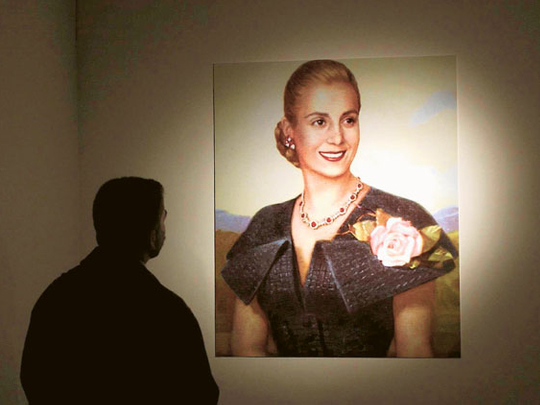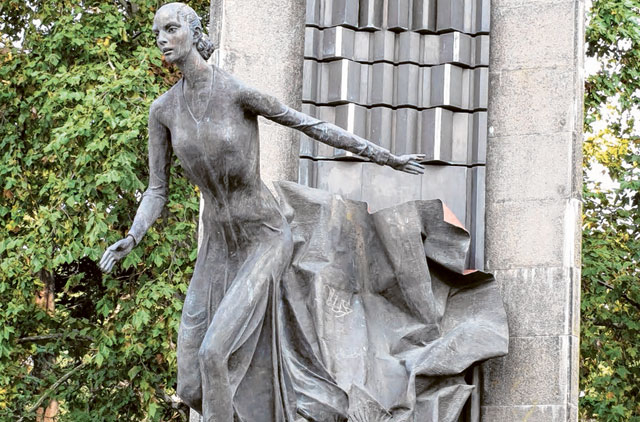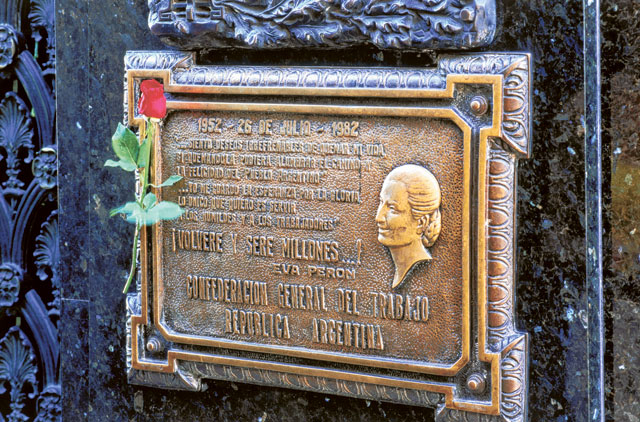
She's everywhere. From the emblematic pink presidential palace in the centre of the city to the massive Retiro Station, which is considered one of the finest buildings in the world. From the slightly indigent yet colourful La Boca neighbourhood in the south to the affluent Recoleta in the north, she's there.
Indeed, almost 60 years after her death, Eva Peron is alive and well in Buenos Aires. This is the city from where her destiny and Argentina's would meet, intertwine and, in turn, give birth to one of the most told stories of our time.
It's a story of love, of loss, of a statesman, his wife and of a troubled country whose romance with one woman was tragically cut short by disease.
And thanks to Qatar Airways' new direct route to Buenos Aires, which we travelled on, regional travellers are now closer than ever to the land of tango and to Evita, her affectionate name.
Walking the streets of Buenos Aires, and visiting its landmarks, one quickly comes to the realisation of the remarkable life Evita led, and what she achieved in her short 33 years.
Poignant past
Abandoned by her father when she was just a year old, Evita and her four siblings were raised by her mother in an impoverished Buenos Aires province called Junin. Stigmatised and severely poor, survival was a struggle and young Evita soon found her escape in her school plays and concerts. The cinema, she would later recall in an autobiography, was her favourite pastime.
When she turned 15, Evita decided to move to Buenos Aires to pursue her dreams of becoming a movie star. She landed at the historical Retiro Station - one of Argentina's busiest railway stations today. The imposing building, influenced by French architecture, was declared a national monument in 1997. Inside, you will find shops and cafes, including one I thought was very English coffee. Not surprising, since we constantly reminded of how Argentinian rulers yearned for the European way of life.
Coming from her poverty-stricken background, the city would have been unnerving for the young Evita when she landed in 1935. Buenos Aires in the Thirties was known as the Paris of South America, already a bustling city with its cafés, theatres and shops and, of course, the tango.
A touch of culture
Still, history tells us she persevered, landing her first part in a theatrical production. She later turned to modelling and eventually found success as a radio drama actress.
Seven years later, she moved into her own apartment in the posh Recoleta neighbourhood. Another tourist spot which is popular because of its cultural and architectural attractions, Recoleta today is home to the National Fine Arts Museum, or Museo Nacional de Bellas Artes, the Recoleta Cultural Centre and the hauntingly beautiful Recoleta Cemetery.
Featuring perfectly manicured roadside gardens and home to some of the country's most affluent people, the cost of real estate here is one of the highest in Argentina.
The library, a former home
One building of interest is the National Library. Before the unique building was constructed, in its place was La Residencia, the home of presidents, where Evita and her husband, Juan Peron, lived from 1946 until her death in 1952.
However, after the military coup of 1955 when Peron was overthrown, the residence was completely destroyed.
After the library's construction many years later, a bronze statue was erected in its garden, showing Evita who appears to be escaping. Many Argentinians complained when the statue was unveiled, claiming the sculpture, by artist Ricardo Gianetti, showcased their Evita as frail and weak.
But Evita's life, it quickly becomes evident, really began when she met Peron, then Secretary of Labour, at a fundraiser for earthquake victims in 1944. It was love at first sight — a day Evita would later describe as a "marvellous day".
Evita and Peron married at a civil ceremony in 1944 and held a church wedding the next year at the glorious Basílica de Nuestra Senora del Pilar in Recoleta. Inspired by 19th-century colonial architecture, the beautiful church was declared a National Historic Monument in 1942 in recognition of its antiquity and prominence.
Evita quickly established herself as a voice for the people, urging the poor to support her husband when he began his presidential campaign and won in 1946. With that, she also became the first woman in Argentinian history to appear on a public campaign trail with her husband.
As first lady, she worked tirelessly for the underprivileged, setting up the Evita Peron Foundation and began to appeal for the right of Argentinian women to vote. In her campaigns, she used her influence as a radio personality to great effect, often delivering rousing speeches. In 1947 a law was signed granting every woman the right to vote. That same year, she formed the Female Peronist Party, the first women's political party in the country.
The famous balcony
South of Buenos Aires, in the poorer La Boca portside neighbourhood, there is the legendary balcony whence Evita waves, along with Argentinian icons Maradonna and tango singer Carlos Gardel. Tourists can walk around this colourful neighbourhood — built by Italian immigrants and now the haunt of artists — and dance tango on the streets or feast on juicy Argentinian steaks.
But perhaps the most famous of all balconies is that of the Casa Rosada, or the Pink House, the presidential office. This is from where Evita and Peron delivered their historical speeches — and where the now legendary song Don't Cry for Me Argentina, sung by Madonna in the musical based on Evita's life, was filmed.
The Pink House, also called thus because of its colour, continues to be one of the most prominent buildings in the country, mainly because it sits right at the end of the historical Plaza de Mayo square, the location of choice for protests and political events. Although it has undergone various transformations over the years, the first structure was built by Captain Juan de Garay, the founder of Buenos Aires, in 1594.
The voice of the people
Evita was urged by the public to run for vice-presidency, amid great opposition from the elite. She eventually declined the invitation, saying she would much prefer to stay and be the voice of the people to the president, her husband.
There was also another, more sinister reason, though — her health was deteriorating. Despite all treatments for cervical cancer, the disease was advancing, although much of her diagnosis was withheld from her by Peron.
In June 1952, she rode meekly in a parade to celebrate her husband's re-election as president. A month later, Evita died, at 33. Argentina went into mourning at a scale no one had witnessed before. But Evita's story, like all legends, did not end with her death.
A heartbroken Peron had ordered her body to be embalmed only to leave it at the hands of the military rulers who overthrew him in a coup in 1955.
The loss of love
The military rulers immediately banned what had become known as Peronism. It became illegal not only to possess pictures of Evita or Peron but even speak their names. And, for almost 20 years, Evita's corpse disappeared.
Bowing to pressure, the military rulers eventually handed the body to Peron in 1971. Peron, still very much in love, kept it in his dining room and eventually brought it back to Argentina from Italy, where it was hidden, in 1975 when he returned and became president again for the third time.
Evita now rests inside a tomb at the Recoleta Cemmetery, a historically significant tourist destination where some of Argentina's most prominent figures also lie.
Despite the mausoleums seemingly competing against each other in their grandiosity and design, hers, surprisingly modest, continues to attract the most number of visitors, with people even queuing up to place their hands on the marble structure and place flowers.
Just as in her short life, Evita, even in death, continues to capture the imagination of Argentinians and the world.
Did you know?
Juan Peron, Evita's lovelorn husband, founded a city dedicated to her on the outskirts of Buenos Aires in 1947. Called Ciudad Evita or Evita City, the layout of the new neighbourhood was purposely built in the shape of Evita's face profile, and is now considered a national monument.
On 26 July 2002, the 50th anniversary of Eva Peron's death, Museo Evita was opened in her honour. The museum, opened in a building that was once used by the Eva Peron Foundation, houses many of Evita's clothes, portraits, and artistic renderings of her life. For more information, go to EvitaPeron.org










